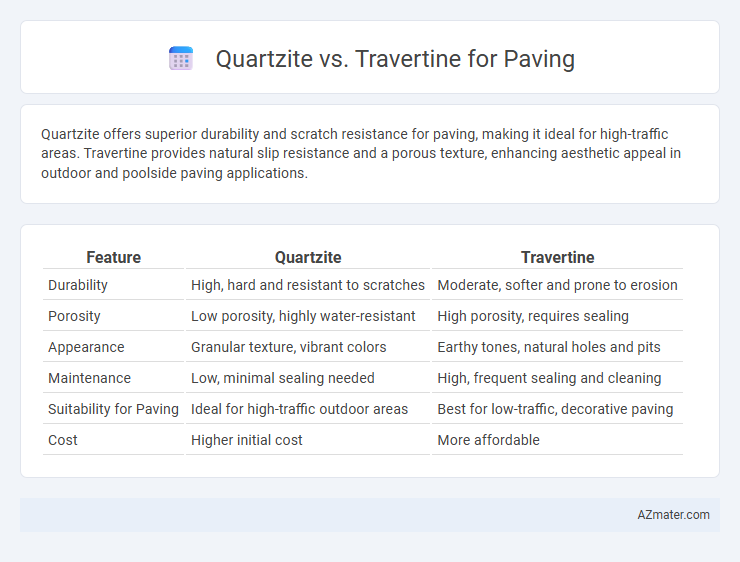Quartzite offers superior durability and scratch resistance for paving, making it ideal for high-traffic areas. Travertine provides natural slip resistance and a porous texture, enhancing aesthetic appeal in outdoor and poolside paving applications.
Table of Comparison
| Feature | Quartzite | Travertine |
|---|---|---|
| Durability | High, hard and resistant to scratches | Moderate, softer and prone to erosion |
| Porosity | Low porosity, highly water-resistant | High porosity, requires sealing |
| Appearance | Granular texture, vibrant colors | Earthy tones, natural holes and pits |
| Maintenance | Low, minimal sealing needed | High, frequent sealing and cleaning |
| Suitability for Paving | Ideal for high-traffic outdoor areas | Best for low-traffic, decorative paving |
| Cost | Higher initial cost | More affordable |
Introduction to Quartzite and Travertine
Quartzite is a natural metamorphic rock formed from sandstone, known for its exceptional hardness, durability, and resistance to weathering, making it ideal for outdoor paving applications. Travertine, a type of limestone deposited by mineral springs, features a porous, textured surface with natural cavities, offering a visually appealing and slip-resistant option for paving areas. Both materials provide distinctive aesthetics and functional benefits, with quartzite excelling in strength and travertine favored for classic elegance and thermal comfort underfoot.
Key Differences Between Quartzite and Travertine
Quartzite is a natural metamorphic rock known for its high durability, hardness, and resistance to scratching, making it ideal for heavy-traffic paving areas. Travertine, a sedimentary limestone, features a porous texture and softer surface, requiring sealing and more maintenance to prevent staining and weathering. Quartzite typically offers a more consistent color palette with a glossy finish, whereas travertine showcases unique natural pits and a matte, textured appearance that adds rustic charm to outdoor paving.
Durability and Strength Comparison
Quartzite offers superior durability and strength compared to travertine, making it an ideal choice for high-traffic paving areas. Its natural hardness and resistance to abrasion withstand heavy foot traffic and weathering better than the softer, more porous travertine. While travertine provides aesthetic appeal with its unique texture, quartzite's exceptional compressive strength ensures longer-lasting performance in demanding outdoor environments.
Aesthetic Appeal and Color Options
Quartzite offers a sleek, glassy finish with a color palette that ranges from white and gray to vibrant blues and greens, enhancing modern and contemporary paving designs. Travertine features a more rustic texture with warm earth tones like beige, cream, and rust, providing a classic, Mediterranean aesthetic ideal for traditional settings. Both materials boast durability, but quartzite's dense composition ensures a brighter, more polished appearance, while travertine's porous surface offers natural variations that appeal to those seeking organic charm.
Slip Resistance and Safety Factors
Quartzite offers superior slip resistance compared to travertine due to its natural rough texture and hardness, making it a safer choice for outdoor paving in wet or high-traffic areas. Travertine, while aesthetically appealing with its porous surface, tends to become slippery when polished or wet, posing potential safety risks. Opting for unpolished or honed finishes on either stone can improve traction, but quartzite's inherent durability and textured surface consistently enhance safety on paved surfaces.
Weather Resistance and Outdoor Performance
Quartzite offers superior weather resistance for paving applications, with exceptional hardness and durability that withstand heavy rain, freeze-thaw cycles, and UV exposure without significant degradation. Travertine performs well in outdoor settings due to its natural porosity allowing for quick drainage, but it requires sealing to prevent water absorption and freeze damage, making maintenance more intensive. Quartzite's non-porous structure and resistance to fading make it a longer-lasting, low-maintenance option for harsh outdoor climates compared to travertine.
Installation Process and Maintenance
Quartzite paving requires professional installation due to its density and hardness, often involving precise cutting and specialized adhesives, ensuring long-term durability. Travertine is easier to install with thinner cuts and flexible mortars, making it suitable for DIY projects but may need sealing to prevent staining. Maintenance for quartzite is minimal, typically involving occasional cleaning and resealing, while travertine demands regular sealing and gentle cleaning to preserve its porous surface and prevent damage.
Cost Analysis: Quartzite vs Travertine
Quartzite typically costs between $15 to $40 per square foot, making it a more expensive option than travertine, which ranges from $3 to $30 per square foot. Quartzite's higher price reflects its superior hardness, durability, and resistance to wear, suitable for heavier traffic areas. Travertine offers budget-friendly versatility but may require more maintenance and sealing to preserve its appearance over time.
Eco-Friendliness and Sustainability
Quartzite offers superior eco-friendliness for paving due to its natural durability and minimal processing requirements, reducing energy consumption and carbon footprint. Travertine, while visually appealing, requires more extensive quarrying and chemical treatments, impacting its sustainability profile negatively. Choosing quartzite supports long-lasting, low-impact paving solutions aligning with sustainable construction practices.
Choosing the Best Stone for Your Project
Quartzite offers superior durability, scratch resistance, and a natural glassy finish, making it ideal for high-traffic paving projects requiring longevity and low maintenance. Travertine provides a unique porous texture and warm earthy tones, enhancing outdoor spaces with slip-resistant surfaces that maintain cool temperatures underfoot. Selecting the best stone depends on balancing quartzite's toughness and sleek appearance against travertine's aesthetic appeal and natural slip resistance for your specific paving needs.

Infographic: Quartzite vs Travertine for Paving
 azmater.com
azmater.com